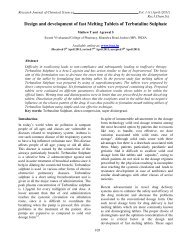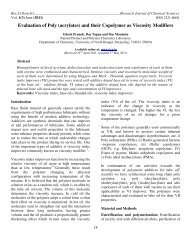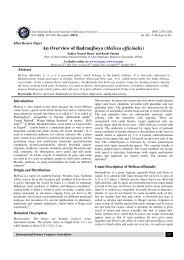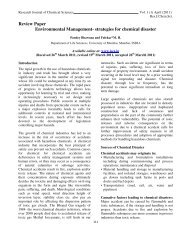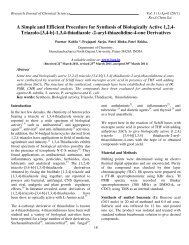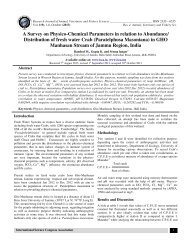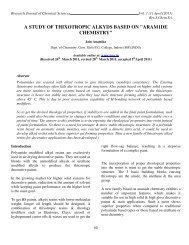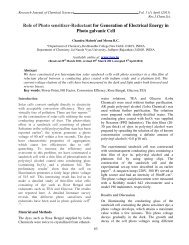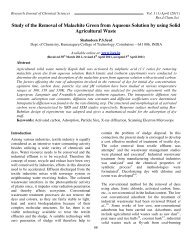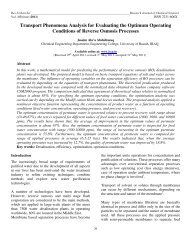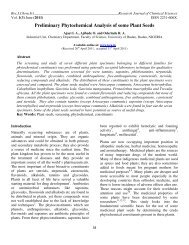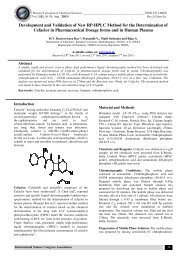Ethnomedicinal Survey of Medicinal Plants Used in the ... - ISCA
Ethnomedicinal Survey of Medicinal Plants Used in the ... - ISCA
Ethnomedicinal Survey of Medicinal Plants Used in the ... - ISCA
Create successful ePaper yourself
Turn your PDF publications into a flip-book with our unique Google optimized e-Paper software.
Research Journal <strong>of</strong> Recent Sciences _________________________________________________ ISSN 2277-2502<br />
Vol. 2(ISC-2012), 5-11 (2013)<br />
Res. J. Recent. Sci.<br />
<strong>Ethnomedic<strong>in</strong>al</strong> <strong>Survey</strong> <strong>of</strong> <strong>Medic<strong>in</strong>al</strong> <strong>Plants</strong> <strong>Used</strong> <strong>in</strong> <strong>the</strong> Treatment <strong>of</strong> Male<br />
Infertilty among <strong>the</strong> IFA Nkari People <strong>of</strong> Ini Local Government Area <strong>of</strong><br />
Akwa Ibom State, Nigeria<br />
Abstract<br />
Erhabor J.O. 1 Idu M. 2 and Udo F.O. 1<br />
1 Departement <strong>of</strong> Plant Biology and Biotechnology, University <strong>of</strong> Ben<strong>in</strong>, P.M.B 1154, Ben<strong>in</strong> City, NIGERIA<br />
2 Benson Idahosa University, PMB, 110, Ben<strong>in</strong> City, NIGERIA<br />
Available onl<strong>in</strong>e at: www.isca.<strong>in</strong><br />
Received 10 th October 2012, revised 25 th Decenber 2012, accepted 26 th January 2013<br />
Over <strong>the</strong> years plants have been used for <strong>the</strong> management and treatment <strong>of</strong> male <strong>in</strong>fertility and it’s gradually ga<strong>in</strong><strong>in</strong>g<br />
grounds due to its availability and affordability. Infertility is <strong>the</strong> <strong>in</strong>ability <strong>of</strong> a couple to have a pregnancy, after one year <strong>of</strong><br />
regular sexual <strong>in</strong>tercourse (3 to 4 times per week) without us<strong>in</strong>g any contraceptive. This survey was carried out to document<br />
medic<strong>in</strong>al plants used <strong>in</strong> <strong>the</strong> treatment <strong>of</strong> male <strong>in</strong>fertility among <strong>the</strong> Ifa Nkari people <strong>of</strong> Ini Local Government Area <strong>of</strong> Akwa<br />
Ibom State, Nigeria. Ethnomedical data were collected by oral <strong>in</strong>terviews us<strong>in</strong>g a semi-structured questionnaire. A total <strong>of</strong><br />
twenty respondents which <strong>in</strong>cluded n<strong>in</strong>eteen (19) males and one (1) female were <strong>in</strong>terviewed. A record <strong>of</strong> thirty-one (31)<br />
medic<strong>in</strong>al plants belong<strong>in</strong>g to twenty-four (24) families with <strong>the</strong>ir botanical descriptions, folk uses, methods <strong>of</strong> preparation,<br />
reported uses, isolated substances and pharmacological effects were documented. The Poaceae family was <strong>the</strong> most<br />
represented with three species followed by Arecaceae, Cucurbitaceae, Liliaceae, Musaceae and Z<strong>in</strong>giberaceae families<br />
which has two species each and o<strong>the</strong>rs one species. Leaves and roots were <strong>the</strong> commonest plant parts used closely followed<br />
by seeds, bark and fruits. The use <strong>of</strong> plants for <strong>the</strong> treatment <strong>of</strong> male <strong>in</strong>fertility has been on <strong>the</strong> <strong>in</strong>crease and <strong>the</strong> current<br />
renewed <strong>in</strong>terest <strong>in</strong> natural products to susta<strong>in</strong> health globally cannot be overemphasized. It is <strong>the</strong>refore recommended that<br />
<strong>the</strong> reported anti-<strong>in</strong>fertility plants be <strong>in</strong>vestigated to ascerta<strong>in</strong> <strong>the</strong>ir safety and efficacy <strong>in</strong> order to improve <strong>the</strong> quality <strong>of</strong> life<br />
<strong>of</strong> man as well as <strong>the</strong> well-be<strong>in</strong>g <strong>of</strong> married couples.<br />
Keywords: Ethnomedic<strong>in</strong>e, medic<strong>in</strong>al plant, male <strong>in</strong>fertility, Ifa Nkari people, Akwa-Ibom State, Nigeria..<br />
Introduction<br />
The World Health Organization <strong>in</strong> 2001 estimated that eighty<br />
percent <strong>of</strong> <strong>the</strong> world population use medic<strong>in</strong>al plants <strong>in</strong> <strong>the</strong><br />
treatment <strong>of</strong> diseases and <strong>in</strong> African countries, this rate is said to<br />
be much higher 1 . It was also estimated that up to 90% <strong>of</strong> <strong>the</strong><br />
population <strong>in</strong> develop<strong>in</strong>g countries rely on <strong>the</strong> use <strong>of</strong> medic<strong>in</strong>al<br />
plants to help meet <strong>the</strong>ir primary health care needs 2 . Aga<strong>in</strong>,<br />
available report show that more than 300 dist<strong>in</strong>ct ethnic groups<br />
mak<strong>in</strong>g up <strong>the</strong> Nigerian society has its own unique <strong>in</strong>digenous<br />
heal<strong>in</strong>g heritage, which has evolved <strong>in</strong> response to <strong>the</strong> specific<br />
experiences and needs <strong>of</strong> its people. Currently, it is estimated<br />
that traditional medic<strong>in</strong>e is <strong>the</strong> only healthcare resource<br />
accessible to a third <strong>of</strong> all Nigerians 3 . In Nigeria, traditional<br />
medic<strong>in</strong>e is used to treat several health conditions <strong>in</strong>clud<strong>in</strong>g<br />
mental disorder, fractures, <strong>in</strong>somnia, and <strong>in</strong>fertility 4 .<br />
Infertility is <strong>the</strong> <strong>in</strong>ability <strong>of</strong> a couple to have a pregnancy, after<br />
regular sexual <strong>in</strong>tercourse (3 to 4 times per week) without<br />
contraceptive method, dur<strong>in</strong>g one year 5,6 . Reduced male fertility<br />
can be <strong>the</strong> result <strong>of</strong> congenital and acquired urogenital<br />
abnormalities, <strong>in</strong>fections <strong>of</strong> <strong>the</strong> genital tract, <strong>in</strong>creased scrotal<br />
temperature (varicocele), endocr<strong>in</strong>e disturbances, genetic<br />
abnormalities and immunological factors 7 . A large proportion <strong>of</strong><br />
<strong>in</strong>fertile men fail to impregnate <strong>the</strong>ir female counterpart because<br />
<strong>of</strong> lack <strong>of</strong> sperm (azoospermia) or too little sperm<br />
(oligozoospermia); abnormal sperm morphology<br />
(tetratozoospermia) and abnormalities <strong>in</strong> sperm motility<br />
(a<strong>the</strong>nozoospermia) 8 . There are evidences to show that sperm<br />
counts have been decl<strong>in</strong><strong>in</strong>g over <strong>the</strong> last 50 years, with a<br />
consequent <strong>in</strong>crease <strong>in</strong> male <strong>in</strong>fertility 9 .<br />
Never<strong>the</strong>less, psychological factors such as stress, guilt,<br />
depression, low self esteem and fear <strong>of</strong> sexual failure cause 10 to<br />
20 percent <strong>of</strong> male <strong>in</strong>fertility cases. The estimated range <strong>of</strong> men<br />
worldwide suffer<strong>in</strong>g from male <strong>in</strong>fertility is from 15 million to 30<br />
million. Reproductive Health care is <strong>the</strong> second most prevalent<br />
health care problem on African Cont<strong>in</strong>ent 10 . Impotency,<br />
premature ejaculation and generally male <strong>in</strong>fertility <strong>in</strong> <strong>the</strong> past<br />
two decades have been <strong>the</strong> focus <strong>of</strong> most research works 11 .<br />
Infertility is a worldwide medical and social problem. Infertility<br />
<strong>in</strong> itself may not threaten physical health but can have serious<br />
impact on <strong>the</strong> mental and social well- be<strong>in</strong>g <strong>of</strong> <strong>in</strong>fertile couple.<br />
It is estimated that <strong>the</strong>re are 60 – 80 million <strong>in</strong>fertile couples<br />
worldwide and above 10–15 % <strong>of</strong> married couples are affected.<br />
In many countries, <strong>the</strong> stigma <strong>of</strong> <strong>in</strong>fertility <strong>of</strong>ten leads to marital<br />
disharmony, divorce or ostracism 12 .<br />
International Science Congress Association 5
Research Journal <strong>of</strong> Recent Sciences ______________________________________________________________ ISSN 2277-2502<br />
Vol. 2(ISC-2012), 5-11 (2013)<br />
Res. J. Recent. Sci.<br />
This study was carried out to source for <strong>in</strong>formation from<br />
traditional medical practitioners on plant remedies used for <strong>the</strong><br />
management and cure <strong>of</strong> male <strong>in</strong>fertility among <strong>the</strong> If a Nkari<br />
people with a view to stimulat<strong>in</strong>g fur<strong>the</strong>r chemical and<br />
biological screen<strong>in</strong>g <strong>of</strong> <strong>the</strong> identified plants for <strong>the</strong> eventual<br />
production <strong>of</strong> drugs that can complement those currently <strong>in</strong> use<br />
<strong>in</strong> <strong>the</strong> treatment <strong>of</strong> <strong>the</strong> ailment.<br />
Study Area: This survey was carried out <strong>in</strong> Ifa Nkari <strong>in</strong> Nkari<br />
clan, Ini Local Government Area <strong>of</strong> Akwa Ibom State,Nigeria.<br />
Ifa Nkari is located on <strong>the</strong> North-West <strong>of</strong> Ini Local Government<br />
Area <strong>of</strong> Akwa Ibom State, Nigeria. Ifa Nkari is one <strong>of</strong> <strong>the</strong> ten<br />
villages that make up Nkari Clan <strong>in</strong> Ini Local Government Area<br />
<strong>of</strong> Akwa Ibom State <strong>of</strong> Nigeria.<br />
Material and Methods<br />
<strong>Ethnomedic<strong>in</strong>al</strong> Information<br />
Source: INI Local Governemnt Area, 2010<br />
Figure-1<br />
MAP <strong>of</strong> INI Local Government Area Show<strong>in</strong>g Study Area<br />
International Science Congress Association 6
Research Journal <strong>of</strong> Recent Sciences ______________________________________________________________ ISSN 2277-2502<br />
Vol. 2(ISC-2012), 5-11 (2013)<br />
Res. J. Recent. Sci.<br />
The ethnomedic<strong>in</strong>al data were collected through an oral<br />
<strong>in</strong>terview <strong>of</strong> <strong>the</strong> herbal practitioners, old men and women<br />
<strong>in</strong>clud<strong>in</strong>g young settlers <strong>in</strong> <strong>the</strong> community us<strong>in</strong>g a semistructured<br />
questionnaire (Appendix 1). Several field trips were<br />
planned and conducted between January and July 2012. The<br />
total respondents were twenty (<strong>of</strong> which n<strong>in</strong>eteen were male and<br />
one female). Data obta<strong>in</strong>ed were collated and tabulated to give<br />
<strong>the</strong> botanical names, common names, families and <strong>the</strong><br />
vernacular or local names <strong>of</strong> <strong>the</strong> various plant species as well as<br />
<strong>the</strong>ir folk use, method <strong>of</strong> preparation, application mode, dosage,<br />
duration <strong>of</strong> treatment and <strong>the</strong> plant part(s) used were recorded.<br />
<strong>Ethnomedic<strong>in</strong>al</strong> confirmations were carried out us<strong>in</strong>g Gill 13 and<br />
local names and uses were also confirmed us<strong>in</strong>g Etukudo 14 .<br />
Species Identification: The <strong>in</strong>digenous plants collected dur<strong>in</strong>g<br />
<strong>the</strong> field trips were identified with <strong>the</strong> assistance <strong>of</strong> Dr. N.U.<br />
Ndaeyo <strong>of</strong> <strong>the</strong> Department <strong>of</strong> Crop Science, University <strong>of</strong> Uyo,<br />
Akwa Ibom State and Mr. J.O. Erhabor <strong>of</strong> <strong>the</strong> Department Plant<br />
Biology and Biotechnology.<br />
Results and Discussion<br />
A total <strong>of</strong> thirty–one (31) medic<strong>in</strong>al plant used by <strong>the</strong> people <strong>of</strong><br />
Ifa Nkari for <strong>the</strong> treatment <strong>of</strong> male <strong>in</strong>fertility were documented<br />
and identified <strong>in</strong> <strong>the</strong> study area. The identified plant species<br />
belong to twenty-four (24) families and thirty (30) genera.<br />
However, <strong>in</strong> <strong>the</strong> enumeration, plants are arranged <strong>in</strong> alphabetical<br />
order us<strong>in</strong>g <strong>the</strong> scientific names along with local names,<br />
families, <strong>the</strong> parts used, dosage, method <strong>of</strong> preparation and<br />
ailments treated. <strong>Plants</strong> identified <strong>in</strong> this work have been used<br />
by <strong>the</strong> respondents and accord<strong>in</strong>g to <strong>the</strong>m are quite efficacious.<br />
Indigenous medic<strong>in</strong>al plants form an important component <strong>of</strong><br />
<strong>the</strong> natural wealth <strong>of</strong> <strong>the</strong> people <strong>of</strong> Nigeria 13 . The available<br />
knowledge on <strong>the</strong> use <strong>of</strong> plant preparations <strong>in</strong> traditional<br />
medic<strong>in</strong>e is enormous among <strong>the</strong> people <strong>of</strong> Nigeria. The use <strong>of</strong><br />
medic<strong>in</strong>al plants for <strong>the</strong> treatment <strong>of</strong> male <strong>in</strong>fertility has come a<br />
long way s<strong>in</strong>ce <strong>the</strong> ancient times and is ga<strong>in</strong><strong>in</strong>g ground every<br />
day. Herbal remedies, rang<strong>in</strong>g from those for promot<strong>in</strong>g sperm<br />
production and motility to formulations for <strong>in</strong>creas<strong>in</strong>g<br />
testosterone levels, enhanc<strong>in</strong>g normal function<strong>in</strong>g <strong>of</strong> <strong>the</strong> male<br />
reproductive organs, and streng<strong>the</strong>n<strong>in</strong>g erection and sex drive<br />
are easily available <strong>in</strong> Nigeria 15 .<br />
In <strong>the</strong> enumeration, plants are arranged with scientific names<br />
along with local names, families, <strong>the</strong> parts used, dosage, method<br />
<strong>of</strong> preparation and ailments treated. A total <strong>of</strong> thirty – one (31)<br />
medic<strong>in</strong>al plant used among <strong>the</strong> people <strong>of</strong> Ifa Nkari for <strong>the</strong><br />
treatment <strong>of</strong> male <strong>in</strong>fertility were documented and identified <strong>in</strong><br />
<strong>the</strong> study area. The identified plant species belong to twenty-four<br />
(24) families and thirty (30) genera. Of <strong>the</strong> twenty respondents,<br />
n<strong>in</strong>eteen were male with only one female (table-4). The family<br />
(Poaceae) is <strong>the</strong> most represented with three species followed by<br />
Arecaceae, Cucurbitaceae, Liliaceae, Musaceae and<br />
Z<strong>in</strong>giberaceae families which has two species each and <strong>the</strong> rest<br />
with one species (table 2). Most <strong>of</strong> <strong>the</strong> preparations <strong>of</strong> <strong>the</strong> herbal<br />
medications were ma<strong>in</strong>ly by gr<strong>in</strong>d<strong>in</strong>g, chew<strong>in</strong>g, boil<strong>in</strong>g, ei<strong>the</strong>r<br />
soaked <strong>in</strong> w<strong>in</strong>e palm or local g<strong>in</strong>. The adm<strong>in</strong>istration <strong>of</strong> herbal<br />
medications was mostly by oral means as none was used topically<br />
(table 1). Leaves and roots were <strong>the</strong> commonest plant parts used<br />
closely followed by seeds, bark and fruits (table 3). This agrees<br />
with <strong>the</strong> f<strong>in</strong>d<strong>in</strong>gs <strong>of</strong> Afolayan and Yakubu 15 on <strong>the</strong> method <strong>of</strong><br />
preparation and plant parts used <strong>in</strong> <strong>the</strong> management <strong>of</strong> male<br />
<strong>in</strong>fertility. However, <strong>the</strong> local name <strong>of</strong> Sorghum bicolor could not<br />
be ascerta<strong>in</strong>ed as at <strong>the</strong> time <strong>of</strong> this study.<br />
Maud and Hann<strong>in</strong>gton 16 reported <strong>the</strong> use <strong>of</strong> thirty-three plants<br />
used <strong>in</strong> <strong>the</strong> management <strong>of</strong> sexual impotence and erectile<br />
dysfunction <strong>in</strong> western Uganda, while Afolayan and Yakubu 15<br />
reported <strong>the</strong> use <strong>of</strong> fourteen plant species used <strong>in</strong> erectile<br />
dysfunction management <strong>in</strong> Nigeria as aga<strong>in</strong>st <strong>the</strong> thirty-one plant<br />
species (table 1) encountered dur<strong>in</strong>g <strong>the</strong> course <strong>of</strong> this study. It is<br />
deducible that <strong>the</strong> number <strong>of</strong> plants species used for <strong>the</strong> treatment<br />
and management <strong>of</strong> male <strong>in</strong>fertility is ra<strong>the</strong>r significantly scarce<br />
or few. Therefore <strong>the</strong>re is <strong>the</strong> need for extensive conservation and<br />
massive cultivation <strong>of</strong> <strong>the</strong> under study plant species is to prevent<br />
and protect <strong>the</strong>m from possible ext<strong>in</strong>ction.<br />
Ethnobotanical survey has revealed several reasons for us<strong>in</strong>g<br />
medic<strong>in</strong>al plants <strong>in</strong> <strong>the</strong> management <strong>of</strong> male <strong>in</strong>fertility <strong>in</strong><br />
Nigeria. This <strong>in</strong>cidence <strong>of</strong> sexual <strong>in</strong>adequacies <strong>in</strong> human males<br />
has led to <strong>the</strong> development <strong>of</strong> a number <strong>of</strong> available options but<br />
unfortunately however, <strong>the</strong>se options are too expensive, not<br />
easily available and with some serious side effects 17 . Ariba et<br />
al 18 reported that 42.3% <strong>of</strong> <strong>the</strong> 79 Nigerian cl<strong>in</strong>icians agreed<br />
that many patients prefer native medications to modern drugs.<br />
This also supports <strong>the</strong> use <strong>of</strong> herbs <strong>in</strong> <strong>the</strong> treatment <strong>of</strong> male<br />
<strong>in</strong>fertility <strong>in</strong> Ifa Nkari <strong>in</strong> Akwa Ibom State.<br />
Moreso, it is paramount to note that several authors have given<br />
credence to <strong>the</strong> use <strong>of</strong> most <strong>of</strong> <strong>the</strong>se reported plants on <strong>the</strong>ir use<br />
traditionally or <strong>in</strong> folklore <strong>in</strong> <strong>the</strong> management and <strong>the</strong> treatment <strong>of</strong><br />
male <strong>in</strong>fertility cases. Balj<strong>in</strong>der et al 19 agrees with <strong>the</strong> use <strong>of</strong><br />
Allium sativum, Cissus quadrangularis, Cocos nucifera, Cola<br />
acum<strong>in</strong>ata, Cymbopogon citrates, Garc<strong>in</strong>ia kola, Piper gu<strong>in</strong>eense,<br />
Sesamum <strong>in</strong>dicum, Z<strong>in</strong>giber <strong>of</strong>fic<strong>in</strong>ale <strong>in</strong> <strong>the</strong> treatment <strong>of</strong> male<br />
<strong>in</strong>fertility. Afolayan and Yakubu 15 also agree with <strong>the</strong> reported use<br />
<strong>of</strong> Term<strong>in</strong>alia catapa, Musa paradisiaca, Piper gu<strong>in</strong>eense <strong>in</strong> <strong>the</strong><br />
treatment <strong>of</strong> male <strong>in</strong>fertility. Igoli et al 20 reported <strong>the</strong> use <strong>of</strong><br />
Anthocleista djalonensis and Newbouldia laevis <strong>in</strong> <strong>the</strong> treatment <strong>of</strong><br />
male <strong>in</strong>fertility among <strong>the</strong> Igede people <strong>of</strong> Nigeria. The use <strong>of</strong><br />
Carica papaya, Carpolobia lutea, Citrilus lanatus, Lonchocarpus<br />
cyanescence, Spondias momb<strong>in</strong>, Aframomum melegueta, and<br />
Irv<strong>in</strong>gia gabonensis on <strong>the</strong> treatment <strong>of</strong> male <strong>in</strong>fertility has been<br />
reported by <strong>the</strong>se respective authors 21, 22, 23, 24, 25 .<br />
However, some <strong>of</strong> <strong>the</strong> plant species (Aloe vera, Carica papaya,<br />
Eremomastax speciosa, Gossypium hirsutum, Musa sapientum,<br />
Raphia hookeri, Sorghum bicolor, Tap<strong>in</strong>anthus bangwensis,<br />
Telfaira occidentalis, Zea mays) reported <strong>in</strong> this work has not<br />
been reported <strong>in</strong> literature. These plant species will add to <strong>the</strong><br />
already exist<strong>in</strong>g <strong>in</strong>digenous knowledge <strong>of</strong> plants used <strong>in</strong> <strong>the</strong><br />
treatment <strong>of</strong> male <strong>in</strong>fertility <strong>in</strong> Nigeria and <strong>the</strong> world at large.<br />
International Science Congress Association 7
Research Journal <strong>of</strong> Recent Sciences ______________________________________________________________ ISSN 2277-2502<br />
Vol. 2(ISC-2012), 5-11 (2013)<br />
Res. J. Recent. Sci.<br />
Table-1<br />
Some commonly used plants <strong>in</strong> <strong>the</strong> treatment <strong>of</strong> male <strong>in</strong>fertility among <strong>the</strong> Ifa Nkari People <strong>of</strong> Akwa Ibom State,Nigeria.<br />
Botanical names Family Common Local Plant parts Mode <strong>of</strong> preparations Dosages Ailments<br />
Names names used<br />
Aframomum Z<strong>in</strong>giberaceae Alligator Ntuen-ibok Seed Seeds are crushed and soak A glass thrice daily Low libido and<br />
melegueta K.<br />
pepper,<br />
<strong>in</strong> fresh palm w<strong>in</strong>e (at least us<strong>in</strong>g palm w<strong>in</strong>e weak erection<br />
Schum<br />
gra<strong>in</strong>s <strong>of</strong><br />
paradise<br />
a bottle) or local g<strong>in</strong>. and a shot daily for<br />
dry g<strong>in</strong>.<br />
Allium sativum L. Liliaceae Garlic Etebe-owo<br />
<strong>in</strong>ua<br />
Aloe vera (L)<br />
Webb (A.<br />
Barbadensis<br />
Miller).<br />
Anthocleista<br />
djalonensis A.<br />
Chev<br />
Liliaceae<br />
Loganiaceae<br />
Aloe vera,<br />
Barbados<br />
aloe<br />
Cabbage<br />
tree<br />
Bulbs<br />
Five bulbs <strong>of</strong> garlic, two<br />
bulbs <strong>of</strong> onion, ten pieces<br />
<strong>of</strong> African red pepper and<br />
g<strong>in</strong>ger are crushed and mix<br />
with water and honey.<br />
Akokafid Roots The roots are cut <strong>in</strong>to<br />
pieces and seven hands full<br />
are soaked <strong>in</strong> half a bottle<br />
<strong>of</strong> dry g<strong>in</strong> for ten days.<br />
Ibu<br />
Carica papaya L. Caricaceae Pawpaw Okpod,<br />
popo<br />
Carpolobia lutea<br />
G. Don.<br />
Cissus<br />
quadrangularis<br />
L.<br />
Citrillus<br />
lanatus(Thunb.)<br />
Matsum and<br />
Nakai.<br />
Root, Bark<br />
and Leaf<br />
Fruit<br />
(unripe)<br />
Decoction <strong>of</strong> <strong>the</strong> roots and<br />
barks.<br />
The unripe fruit is cut <strong>in</strong>to<br />
cube size and boiled <strong>in</strong> 8<br />
litres <strong>of</strong> water.<br />
Polygalaceae Cattle stick Ikpafum Root Decoction <strong>of</strong> <strong>the</strong> roots or<br />
<strong>the</strong> roots are thoroughly<br />
washed and chewed.<br />
Vitaceae<br />
Edible-<br />
Stemmedv<strong>in</strong>e<br />
Oborouduk<br />
Cucurbitaceae Melon Ikon,<br />
Okokon<br />
Cocos nucifera L. Arecaceae Coconut Isip<br />
mbakara<br />
Cola acum<strong>in</strong>ata<br />
(P. Beauv.)<br />
Schott and Endl.<br />
Cymbopogon<br />
citratus (DC)<br />
Stapf.<br />
Eremomastax<br />
speciosa<br />
(Hochst).<br />
Garc<strong>in</strong>ia kola<br />
Heckel.<br />
Gossypium<br />
hirsutum L.<br />
Irv<strong>in</strong>gia<br />
gabonensis<br />
(Aubry-Lecomte<br />
ex O’Rorke) Bail.<br />
Jatropha<br />
gossipifolia L.<br />
Three tablespoonful<br />
thrice daily<br />
One tablespoonful<br />
thrice daily<br />
Half a glass thrice<br />
daily<br />
Half a glass thrice<br />
daily<br />
Six tablespoonful<br />
thrice daily, chew<br />
roots until condition<br />
improves<br />
Root Decoction <strong>of</strong> <strong>the</strong> roots. Two tablespoonful<br />
thrice daily<br />
Seed<br />
Coconut<br />
liquid<br />
The seeds are used to<br />
prepare melon (egusi) soup<br />
and it should be half<br />
cooked.<br />
The outer layer <strong>of</strong> <strong>the</strong><br />
coconut is removed and <strong>the</strong><br />
nut cracked to obta<strong>in</strong> <strong>the</strong><br />
fresh juice.<br />
Sterculiaceae Kola nut Ibon Pericarp Mix ten kola nut pericarps<br />
with five raw eggs, two<br />
bottles <strong>of</strong> lime juice, one<br />
bottle <strong>of</strong> water, and one<br />
bottle <strong>of</strong> honey.<br />
Poaceae<br />
Acanthaceae<br />
Lemon<br />
grass<br />
Golden<br />
seal,<br />
African<br />
blood tonic<br />
plant<br />
Ebana Leaf The decoction <strong>of</strong> <strong>the</strong><br />
Leaves is mix with honey.<br />
Edem<br />
Ididout,<br />
Ndanaedem<br />
Leaf<br />
The leaves are washed and<br />
juice is extracted by<br />
squeez<strong>in</strong>g <strong>the</strong> leaves <strong>in</strong><br />
water.<br />
Guttiferae Bitter kola Efiad Seed Seed is crushed and t<strong>in</strong>cture<br />
made with g<strong>in</strong> or fresh<br />
palm w<strong>in</strong>e.<br />
Malvaceae<br />
Irv<strong>in</strong>giaceae<br />
Euphorbiacea<br />
e<br />
Cotton<br />
plant<br />
Bush<br />
mango,<br />
African<br />
Mango<br />
Wild<br />
cassada,<br />
belly-ache<br />
bush<br />
Ikro afor Leaf Leaves are washed and<br />
boiled <strong>in</strong> adequate water to<br />
extract juice.<br />
Uyo Seed Gr<strong>in</strong>d one tomato t<strong>in</strong> can <strong>of</strong><br />
<strong>the</strong> seeds and mix with 75cl<br />
<strong>of</strong> pure honey.<br />
Eto-eko<br />
obio nsit<br />
Stem bark The bark washed<br />
thoroughly and t<strong>in</strong>cture<br />
made.<br />
The patient should<br />
eat egusi soup<br />
regularly<br />
One glass daily for<br />
as long as it is<br />
needed<br />
One shot thrice<br />
daily for three<br />
months and alcohol<br />
<strong>in</strong>take should be<br />
discont<strong>in</strong>ued dur<strong>in</strong>g<br />
treatment<br />
Half a glass twice<br />
daily<br />
Six tablespoonful<br />
twice daily.<br />
Two shot thrice<br />
daily<br />
Half a glass daily<br />
One spoonful twice<br />
daily.<br />
A shot three daily<br />
Low libido<br />
Low libido<br />
General <strong>in</strong>fertility<br />
ailments<br />
General <strong>in</strong>fertility<br />
ailments<br />
General <strong>in</strong>fertility<br />
ailments<br />
General <strong>in</strong>fertility<br />
ailments<br />
Low sperm count<br />
and low libido<br />
General <strong>in</strong>fertility<br />
ailments<br />
Low sperm count<br />
and weak erection<br />
Weak erection and<br />
General <strong>in</strong>fertility<br />
ailments.<br />
General <strong>in</strong>fertility<br />
ailments<br />
Weak erection<br />
General <strong>in</strong>fertility<br />
ailments<br />
Low sperm count<br />
and impotency.<br />
General <strong>in</strong>fertility<br />
ailments<br />
International Science Congress Association 8
Research Journal <strong>of</strong> Recent Sciences ______________________________________________________________ ISSN 2277-2502<br />
Vol. 2(ISC-2012), 5-11 (2013)<br />
Res. J. Recent. Sci.<br />
Lonchocarpus<br />
cyanescens<br />
(Schum. and<br />
Thonn.) Benth.<br />
Musa<br />
paradisciaca L.<br />
Musa sapientum<br />
L.<br />
Newbouldia<br />
laevis (P. Beauv)<br />
Seeman ex<br />
Bureau.<br />
Piper gu<strong>in</strong>eense<br />
Schum and<br />
Thonn.<br />
Raphia hookeri<br />
Mann and<br />
Wendland.<br />
Sesamum <strong>in</strong>dicum<br />
L.<br />
Spondias momb<strong>in</strong><br />
L.<br />
Sorghum bicolor<br />
L.<br />
Tap<strong>in</strong>anthus<br />
bangwensis<br />
(Engl. and K.<br />
Krause)<br />
Telfaira<br />
occidentialis<br />
Hook. F.<br />
Term<strong>in</strong>alia<br />
catapa L.<br />
Xylopia<br />
aethiopica<br />
(Dunal) A. Rich.<br />
Fabaceae<br />
West<br />
African<br />
Indigo<br />
Musaceae Planta<strong>in</strong> Ukom,<br />
Mbr<strong>in</strong>yon<br />
Awa Leaf Leaves are washed and put<br />
<strong>in</strong> a pot <strong>of</strong> water <strong>the</strong>n<br />
boiled.<br />
Root<br />
unripe.<br />
Fruit,<br />
Sucker<br />
juice<br />
The root are soaked <strong>in</strong> palm<br />
w<strong>in</strong>e or dry g<strong>in</strong>. The juice<br />
from <strong>the</strong> stem is taken<br />
orally. The unripe fruit can<br />
also be roasted and taken<br />
orally.<br />
Musaceae Banana Mboro Root The roots are soaked <strong>in</strong><br />
palm w<strong>in</strong>e or dry g<strong>in</strong>.<br />
Bignoniaceae Boundary Itumo, Stem bark The bark <strong>of</strong> <strong>the</strong> stem is<br />
tree, Oboti,<br />
soaked <strong>in</strong> dry g<strong>in</strong> and<br />
chiefta<strong>in</strong>cy Oniok<br />
allowed for few hours.<br />
tree<br />
Piperaceae<br />
Gu<strong>in</strong>ea<br />
black<br />
pepper<br />
Et<strong>in</strong>kene,<br />
Odusa<br />
Root,<br />
leaves and<br />
fruits<br />
Decoction <strong>of</strong> <strong>the</strong> leaves and<br />
roots. A t<strong>in</strong>cture fruits and<br />
seeds are also very essential<br />
or <strong>the</strong> seeds could also be<br />
used also <strong>in</strong> prepar<strong>in</strong>g<br />
pepper soup yam.<br />
Arecaceae W<strong>in</strong>e palm Ukod Root The remedy is prepared by<br />
mak<strong>in</strong>g a t<strong>in</strong>cture <strong>of</strong> <strong>the</strong><br />
root <strong>of</strong> <strong>the</strong> plant us<strong>in</strong>g g<strong>in</strong><br />
or palm w<strong>in</strong>e.<br />
Pedaliaceae Sesame, Etekhede, Seeds The seeds are eaten or <strong>the</strong><br />
Beniseed Udot Iyeiye<br />
seeds extract taken orally.<br />
Anacardiacea<br />
e<br />
Poaceae<br />
Loranthaceae<br />
Cucurbitaceae<br />
Combretaceae<br />
Annonaceae<br />
Hog plum,<br />
yellow<br />
momb<strong>in</strong><br />
Gu<strong>in</strong>ea<br />
corn<br />
African<br />
Mistletoe<br />
Fluted<br />
pumpk<strong>in</strong><br />
Indian<br />
almond<br />
African<br />
pepper,<br />
Ethiopian<br />
pepper,<br />
Gu<strong>in</strong>ea<br />
pepper.<br />
Nsukakara Leaf The remedy is prepared by<br />
boil<strong>in</strong>g <strong>the</strong> leaves<br />
Ndot eyong<br />
Ubon, ikon<br />
ubon<br />
Mansang<br />
mbakara<br />
Ata<br />
Straw<br />
Leaves,<br />
Roots and<br />
Stems<br />
Gu<strong>in</strong>ea corn straw, guava<br />
roots, coconut root, male<br />
pawpaw root, g<strong>in</strong>ger and<br />
green leafy onion are<br />
soaked <strong>in</strong> g<strong>in</strong>, (brandy) or<br />
Soda water.<br />
The leaves, stems and roots<br />
are boiled and allow to cool<br />
down.<br />
Leaf The Leaves <strong>of</strong> fluted<br />
pumpk<strong>in</strong> and that <strong>of</strong><br />
Solanum melongena are<br />
squeezed <strong>in</strong> water to extract<br />
juice and little honey<br />
added.<br />
Two shot thrice<br />
daily.<br />
Two shot twice for<br />
root t<strong>in</strong>cture, one<br />
glass <strong>of</strong> juice once<br />
every three days.<br />
Two roasted unripe<br />
planta<strong>in</strong> fruit daily.<br />
Two shot twice<br />
daily.<br />
Two shot twice a<br />
day<br />
Half glass cup daily<br />
for leaves and root<br />
decoction. One shot<br />
daily for <strong>the</strong><br />
t<strong>in</strong>cture.<br />
Two shot twice<br />
daily<br />
Two teaspoonful<br />
daily<br />
One glass thrice<br />
daily<br />
One shot thrice<br />
daily (g<strong>in</strong>). Half<br />
glass thrice daily<br />
(soda water).<br />
Two glass twice<br />
daily<br />
One glass twice<br />
daily<br />
Fruits No preparation Eat fruit as long as<br />
necessary.<br />
Fruits,<br />
seeds,<br />
Bark<br />
The fruits, barks and seeds<br />
are soaked <strong>in</strong> palm w<strong>in</strong>e.<br />
The fruits and seeds can<br />
also be used to prepare<br />
pepper soup for <strong>the</strong> patient.<br />
Z<strong>in</strong>giber<br />
<strong>of</strong>fic<strong>in</strong>ale Roscoe.<br />
Z<strong>in</strong>giberaceae G<strong>in</strong>ger Rhizome The juice extracted from<br />
g<strong>in</strong>ger is mixed with honey.<br />
Zea mays L. Poceae Maize, corn Akpakpa, Seeds Two cups <strong>of</strong> maize gra<strong>in</strong>s<br />
abakpa,<br />
or seeds powdered) are<br />
ibokpod.<br />
mixed with adequate palm<br />
w<strong>in</strong>e and filtered. The<br />
filtrate is taken orally.<br />
One glass daily<br />
Three table spoonful<br />
thrice daily<br />
One glass twice<br />
daily.<br />
Low sperm count<br />
Weak erection,<br />
low sperm count<br />
and aphrodisiac<br />
Weak erection and<br />
aphrodisiac<br />
General <strong>in</strong>fertility<br />
ailments<br />
Weak Erection<br />
and Impotency<br />
Weak erection and<br />
as an aphrodisiac.<br />
General <strong>in</strong>fertility<br />
ailments.<br />
General <strong>in</strong>fertility<br />
ailments<br />
General <strong>in</strong>fertility<br />
ailments<br />
General <strong>in</strong>fertility<br />
ailments<br />
It is used to treat<br />
general <strong>in</strong>fertility<br />
ailments<br />
Weak erection,<br />
premature<br />
ejaculation, low<br />
sperm count.<br />
General <strong>in</strong>fertility<br />
ailments<br />
Weak erection<br />
General <strong>in</strong>fertility<br />
ailments<br />
International Science Congress Association 9
Research Journal <strong>of</strong> Recent Sciences ______________________________________________________________ ISSN 2277-2502<br />
Vol. 2(ISC-2012), 5-11 (2013)<br />
Res. J. Recent. Sci.<br />
Table-2<br />
Distribution <strong>of</strong> species among <strong>the</strong> family <strong>of</strong> plants collected<br />
Family<br />
Number <strong>of</strong> species<br />
Acanthaceae 1<br />
Anacardiaceae 1<br />
Annonaceae 1<br />
Arecaceae 2<br />
Bignoniaceae 1<br />
Caricaceae 1<br />
Combretaceae 1<br />
Cucurbitaceae 2<br />
Euphorbiaceae 1<br />
Fabaceae 1<br />
Guttiferae 1<br />
Irv<strong>in</strong>giaceae 1<br />
Liliaceae 2<br />
Loganiaceae 1<br />
Lorantaceae 1<br />
Malvaceae 1<br />
Musaceae 2<br />
Pedaliaceae 1<br />
Piperaceae 1<br />
Poaceae 3<br />
Polygalaceae 1<br />
Sterculiaceae 1<br />
Vitaceae 1<br />
Z<strong>in</strong>giberaceae 2<br />
Table-3<br />
Frequency <strong>of</strong> plant parts used<br />
Plant Parts used<br />
Frequency<br />
Root 9<br />
Leaf 9<br />
Seed 7<br />
Fruit 5<br />
Bark 4<br />
Bulb 1<br />
Coconut liquid 1<br />
Pericarp 1<br />
Rhizome 1<br />
Sucker Juice 1<br />
Table-4<br />
Number <strong>of</strong> Respondents<br />
No. <strong>of</strong> Respondents Male Female<br />
20 19 1<br />
Conclusion<br />
Nigeria has a vast heritage <strong>of</strong> medic<strong>in</strong>al and traditional<br />
knowledge. The use <strong>of</strong> traditional or <strong>in</strong>digenous knowledge has<br />
cont<strong>in</strong>ues to play a vital role <strong>in</strong> health care delivery <strong>in</strong> Nigeria<br />
and will cont<strong>in</strong>ue to play a major role as long as modern health<br />
care facilities cont<strong>in</strong>ues to be an illusion and unavailable to <strong>the</strong><br />
vast majority <strong>of</strong> <strong>the</strong> populace. However, <strong>the</strong>re is an urgent need<br />
for <strong>the</strong> search to preserve our diversity as <strong>the</strong> rapid ext<strong>in</strong>ction <strong>of</strong><br />
plant species is on <strong>the</strong> <strong>in</strong>crease. Fur<strong>the</strong>r <strong>in</strong>vestigations and<br />
enquiry <strong>in</strong>to <strong>the</strong> safety and efficacy <strong>of</strong> <strong>the</strong>se plant species used<br />
<strong>in</strong> <strong>the</strong> treatment and management <strong>of</strong> male <strong>in</strong>fertility is strongly<br />
recommended.<br />
References<br />
1. WHO. Legal Status <strong>of</strong> Traditional Medic<strong>in</strong>e and<br />
Complementary and Alternative medic<strong>in</strong>e: A Worldwide<br />
Review, 200 (2001)<br />
2. WHO Traditional medic<strong>in</strong>e – grow<strong>in</strong>g needs and<br />
potentials, Who Pol. Persp. on Med., 2, 1–6 (2002)<br />
3. Ogunbodede A. J., Mental illness and traditional <strong>the</strong>rapy <strong>in</strong><br />
Nigeria, Ibom J. Soc. Issues, 4, 56-66 (1997)<br />
4. Enwereji E., Views on tuberculosis among <strong>the</strong> Igbo <strong>of</strong><br />
Nigeria, Indig. Know. and Dev. Monitor, 7, 4–7 (1999)<br />
5. Salgado J.T.R., Hernandez M., Ayala A., Frequency <strong>of</strong><br />
altered male factor <strong>in</strong> <strong>in</strong>fertility cl<strong>in</strong>ic, Gyn and Obst, 71,<br />
233-237 (2003)<br />
6. Ojobo S., Management <strong>of</strong> Infertility amongst Nigerian<br />
Couples, The way forward. Women’s Health and Action<br />
Research Centre. Community Education Lecture Series<br />
2007 WHARC, Ben<strong>in</strong> City, Nigeria, 26 (2007)<br />
7. WHO. WHO Manual for <strong>the</strong> standardised <strong>in</strong>vestigation<br />
and diagnosis <strong>of</strong> <strong>the</strong> <strong>in</strong>fertile male Cambridge University<br />
Press, Cambridge, 102 (2000)<br />
8. Feng H.L., Molecular biology <strong>of</strong> male <strong>in</strong>fertility, Arch. <strong>of</strong><br />
Andr., 49,19-27 (2003)<br />
9. Carlsen E., Giwercman A.J., Keid<strong>in</strong>g N., Skakkebaek<br />
N.E., Decl<strong>in</strong>e<strong>in</strong> semen quality from 1930 to 1991,<br />
UgeskrLaeger, 155, 2230-2235 (1993)<br />
10. Ch<strong>in</strong>noch P., Reproductive Health, Afri. Health, 18 3-19<br />
(1996)<br />
11. Kulkani S.K. and Reddy D.S. Pharmaco<strong>the</strong>rapy <strong>of</strong> Male<br />
Erectile Dysfuction with Sildenafil, Indian J. <strong>of</strong><br />
Pharmacol, 30, 367-378 (1990)<br />
12. WHO. B<strong>in</strong>nial Report, Prevention <strong>of</strong> Infertility from 1992–<br />
1993 Edt, J. Khanna, Office <strong>of</strong> Publication, WHO,<br />
Geneva, 32 – 33,161-166 (1993)<br />
13. Gill L.S., <strong>Ethnomedic<strong>in</strong>al</strong> Uses <strong>of</strong> <strong>Plants</strong> <strong>in</strong> Nigeria.<br />
Uniben Press, Nigeria, 276 (1992)<br />
International Science Congress Association 10
Research Journal <strong>of</strong> Recent Sciences ______________________________________________________________ ISSN 2277-2502<br />
Vol. 2(ISC-2012), 5-11 (2013)<br />
Res. J. Recent. Sci.<br />
14. Etukudo I., Ethnobotany Conventional and traditional uses<br />
<strong>of</strong> plant. The Verdict Press, Uyo, Nigeria 191 (2003)<br />
15. Afolayan J.D. and Yakubun M.T., Erectile dysfunction<br />
management options <strong>in</strong> Nigeria, J. <strong>of</strong> Sexual Med., 6,<br />
1090-1102 (2008)<br />
16. Maud K.M. and Hann<strong>in</strong>gton O.O., Traditional herbal<br />
remedies used <strong>in</strong> <strong>the</strong> management <strong>of</strong> sexual impotence and<br />
erectile dysfunction <strong>in</strong> Western Uganda, Afri. Health Sci.,<br />
5, 40-48 (2005)<br />
17. Yakubu M.T., Akani M.A. and Oladiji A.T., Male sexual<br />
dysfunction and methods used <strong>in</strong> assess<strong>in</strong>g medical plants<br />
with aphrodisiac potentials, Pharma. Rev., 1, 49-56 (2007)<br />
18. Ariba A.J., Oladipo O.T., Iyaniwura C.A., Dada O. A.,<br />
Management <strong>of</strong> Erectile dysfunction: Perception and<br />
practices <strong>of</strong> Nigerian primary care cl<strong>in</strong>icians, S. Afri.<br />
Family Prac., 49, 16a-d (2007)<br />
19. Balj<strong>in</strong>der, S., Vikas, G., Parveen, B., Ranjit, S.,<br />
Dharmendra K., Pharmacological potential <strong>of</strong> plant used as<br />
aphrodisiacs, Intl. J. <strong>of</strong> Pharm. Scns Rev. and Res., 5, 104-<br />
113 (2010)<br />
20. Igoli J.O. Ogaji O.G., Tor-Anyi<strong>in</strong> T.A., Igoli<br />
N.P.,Traditional medic<strong>in</strong>e practice amongst <strong>the</strong> Igede<br />
people <strong>of</strong> Nigeria. Part II. Afri. J. <strong>of</strong> Trad., Compl. and<br />
Altern. Med, 2, 134 –152 (2005)<br />
21. Kafaru E., Immense help from Nature’s Workshop. Elikaf<br />
Health Services ltd. Ikeja, Lagos, 212p (1994)<br />
22. Burkill H.M., The Useful <strong>Plants</strong> <strong>of</strong> West Tropical Africa.<br />
The Whitefriars Press Limited, Great Brita<strong>in</strong>, 960 (1985)<br />
23. Yativ M., Harary I., Wolf S., Sucrose accumulation <strong>in</strong><br />
watermelon fruits: Genetic variation and biochemical<br />
analysis, Journal <strong>of</strong> Plant Physiology, 167, 589-596 (2010)<br />
24. Aiyeloja A.A. and Bello O.A. Ethnobotanical potentials <strong>of</strong><br />
common herbs <strong>in</strong> Nigeria: A case study <strong>of</strong> Enugu state,<br />
Edu. Res. and Rev. 1, 6-22 (2006)<br />
25. Lawal I.O., Uzokwe N.E., Igboanugo A.B.I., Adio A.F.,<br />
Awosan E.A., Nwogwugwu J.O., Faloye B., Olatunji B.P.,<br />
Adesoga A.A. <strong>Ethnomedic<strong>in</strong>al</strong> <strong>in</strong>formation on collation<br />
and identification <strong>of</strong> some medic<strong>in</strong>al plants <strong>in</strong> Research<br />
Institutes <strong>of</strong> South-west Nigeria, Afri. J. <strong>of</strong> Pharm. and<br />
Pharmacol, 4, 1-7 (2010)<br />
International Science Congress Association 11



